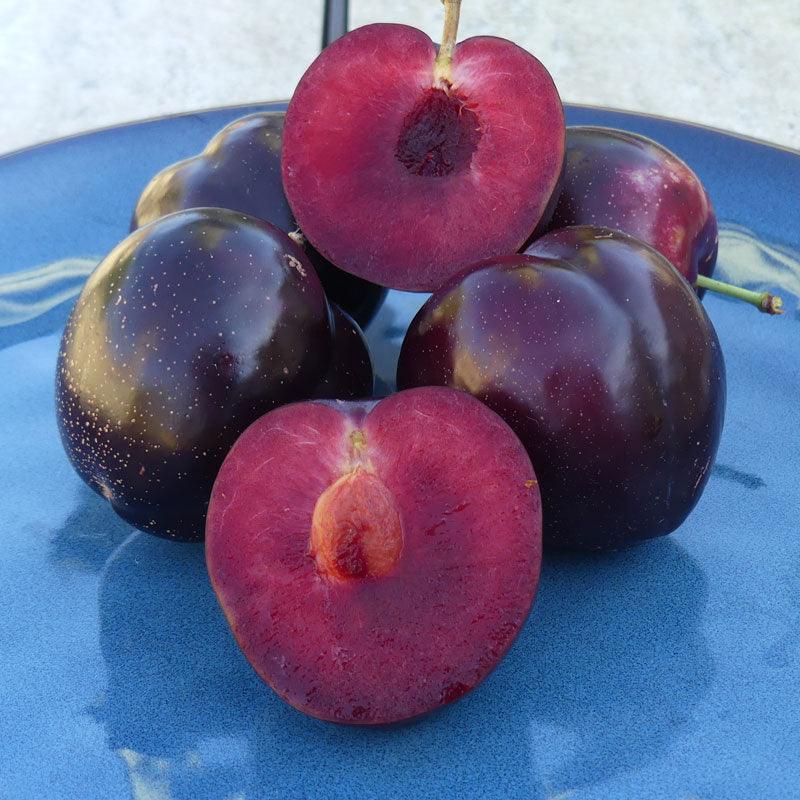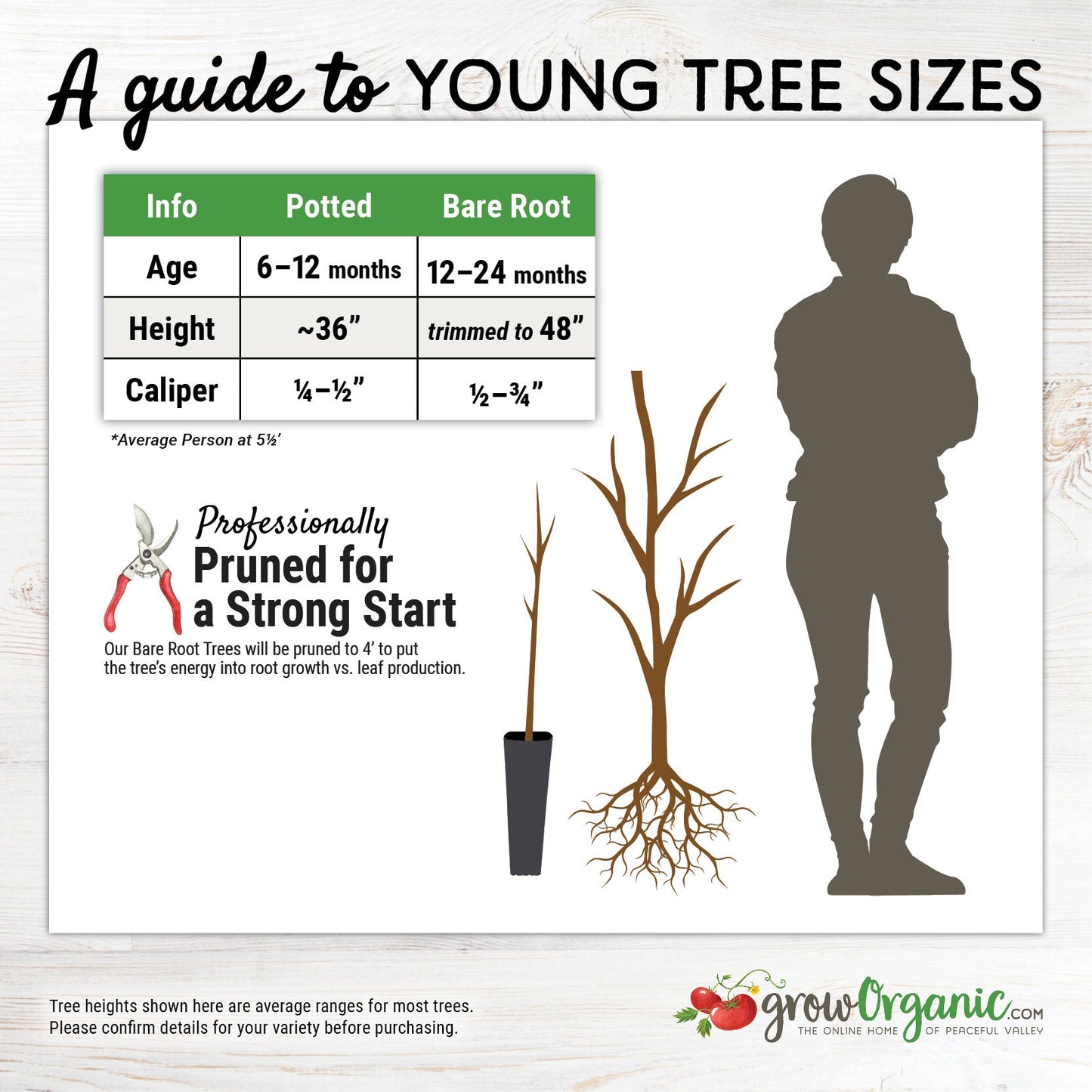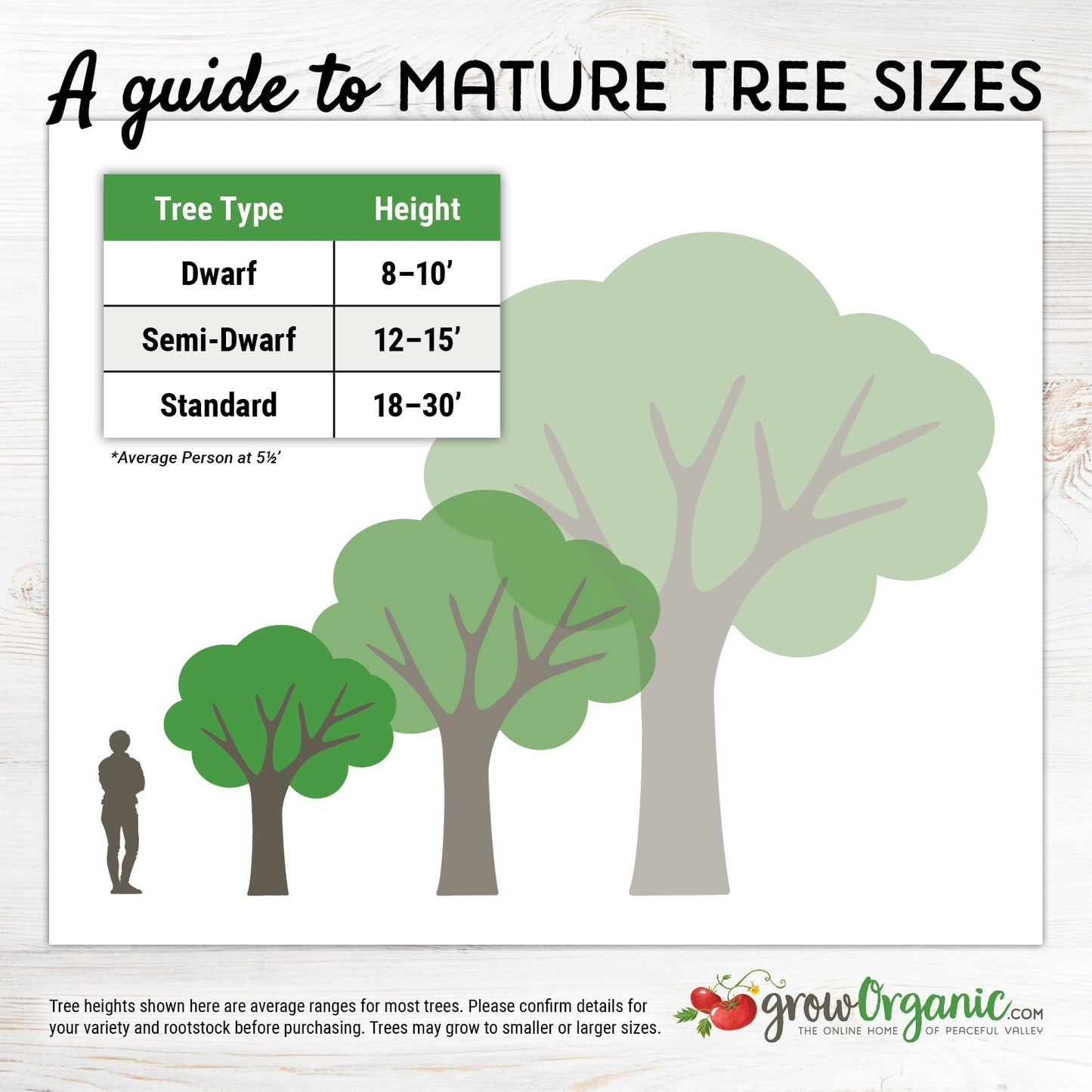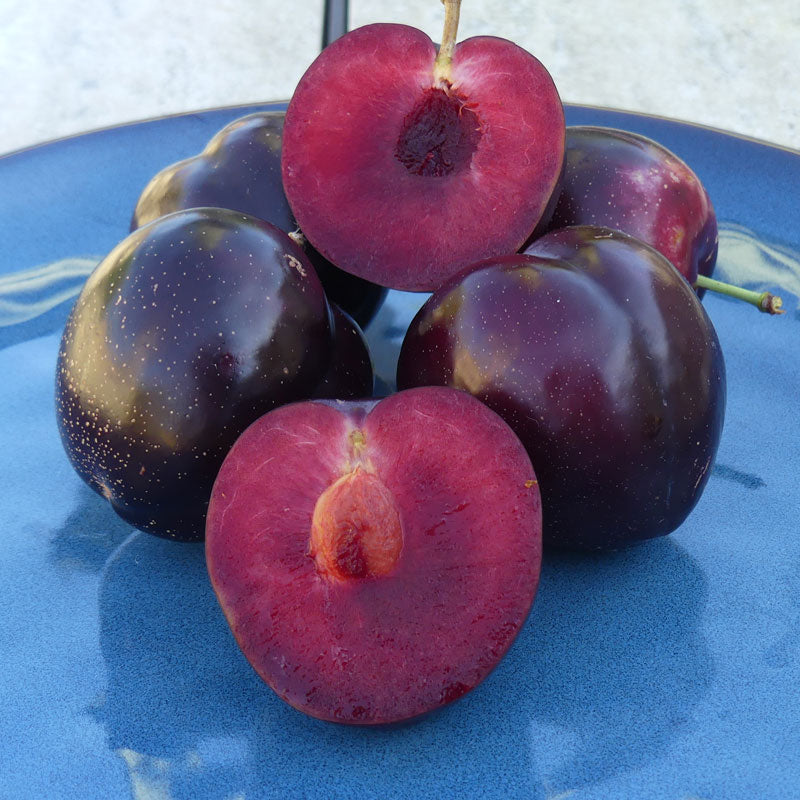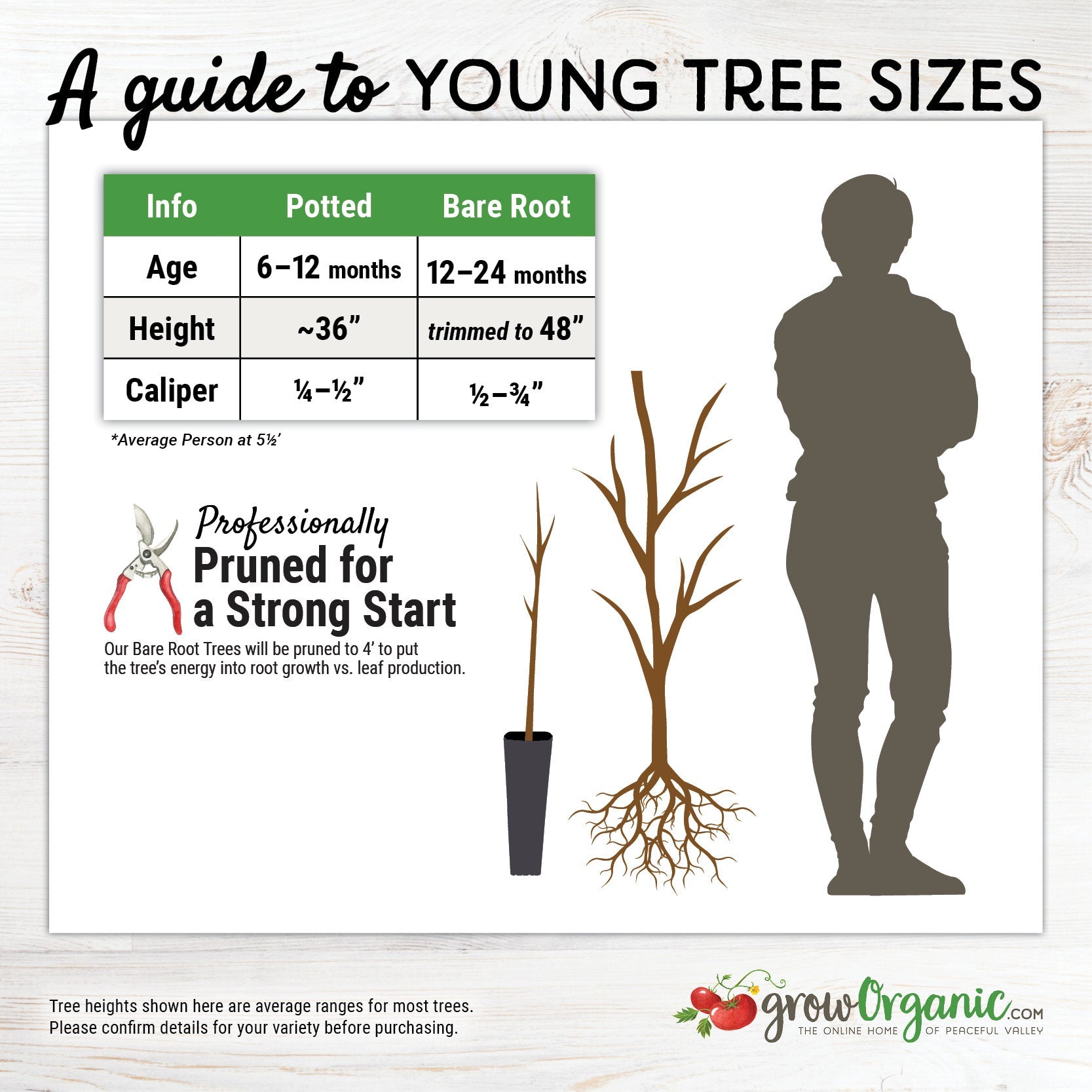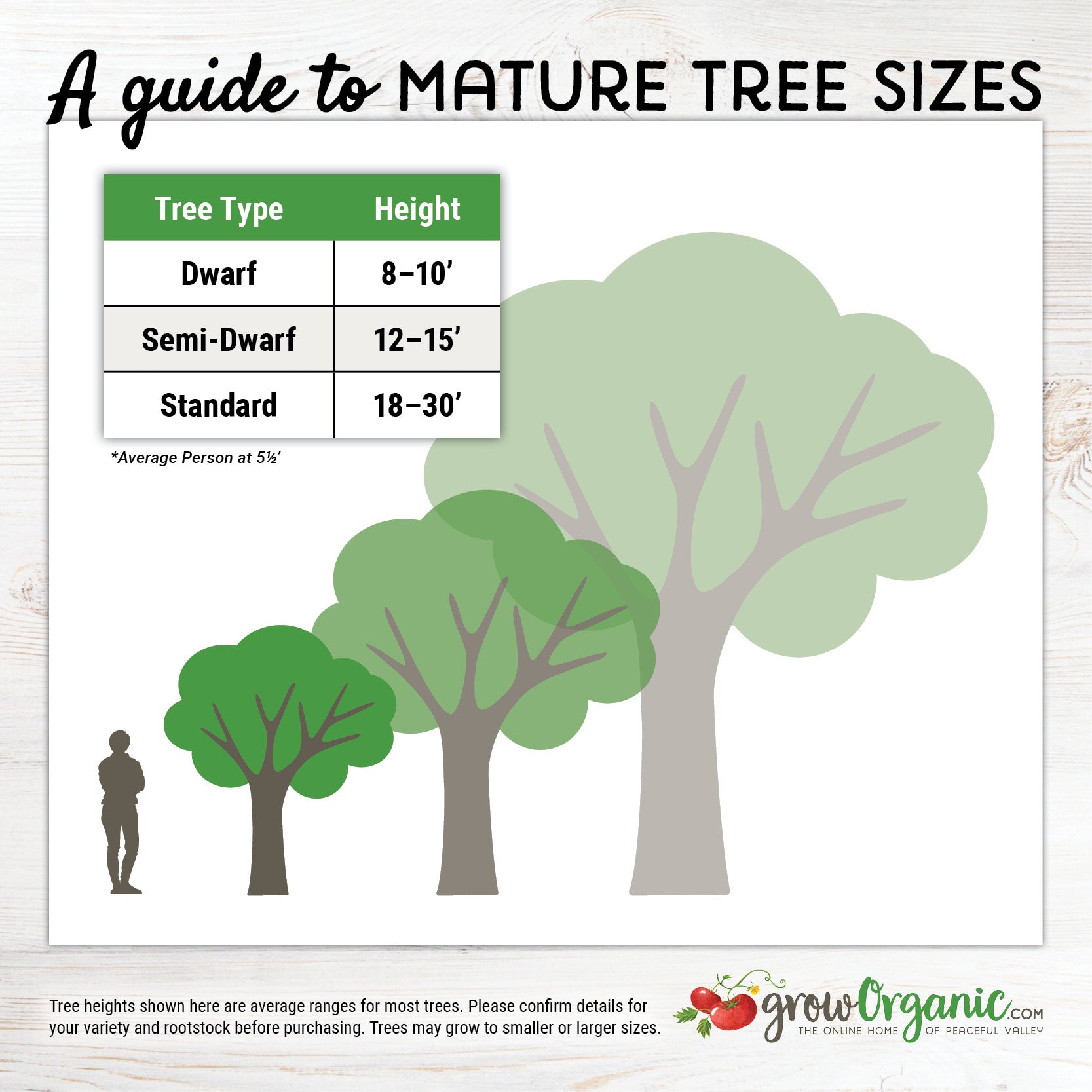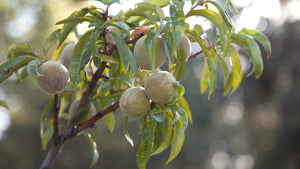Item Number: FT214
Burgundy Plum Tree
Burgundy Plum Tree
Productive, Sweet Plum
Semi-dwarf on Citation rootstock.
- Zones: 7-9
- Chill hours: 300-400
- Harvest: July-August
- Looks: Maroon-colored skin with semi-freestone flesh.
- Personality: Sweet with little or no tartness and a pleasing, mild flavor.
- Facts of note: The Burgundy Plum is an exciting versatile plum that is not only great tasting, harvests over a long period, but also is one of the best pollinators for your other plum varieties. Named for it's deep dark red flesh like no other. the self-fruitful Burgundy plum has burgundy-colored skin, is a semi-freestone, with sweet dark red burgundy flesh with little or no tartness. This fruit eats well early when the flesh first turns red. At this time the fruit is firm with a great snap and crunch with a slight bite to the skin. Ripening over a 2 month period the fruit continues to improve in sweetness, the bite to the skin goes away and the fruits unique mild flavor grows. This is a top taste test winner in numerous test conducted over the years. Burgundy is an all-purpose home garden plum, delicious for fresh eating, cooking, drying and in jams and jellies. Burgundy has also proven to be one of the best pollinators for other Japanese plums and most all Pluots.
- Pollination: Self-fruitful; pollenizer for most other plums.
The Burgundy Japanese Plum Tree (Prunus salicina 'Burgundy') is a semi-dwarf fruit tree that captivates gardeners and fruit enthusiasts with its exquisite appearance and delectable harvest. This deciduous tree is a prized addition to orchards, gardens, and landscapes, offering not only ornamental value but also a bountiful supply of sweet and juicy plums.
Tree Characteristics
Semi-Dwarf Stature: The Burgundy Japanese Plum Tree typically attains a manageable height, making it suitable for various garden sizes and spaces. Its semi-dwarf nature allows for easier care and harvesting.
Burgeoning Blossoms: In early spring, this plum tree graces the landscape with a profusion of delicate, fragrant blossoms. Clusters of beautiful pink or white flowers create a stunning display, attracting pollinators and announcing the forthcoming fruit.
Foliage and Shape: The tree's leaves are oval and deep green, providing an attractive backdrop for its vibrant blooms and later, its plump fruit. Its growth habit is rounded and compact, offering a neat and symmetrical appearance.
Fruit Production
Delicious Plums: The Burgundy Japanese Plum Tree produces plums that are renowned for their exceptional flavor and juiciness. These plums are large, often with a deep burgundy or dark purple skin and sweet, firm flesh. The flavor profile is a harmonious blend of sweetness and tartness.
Harvest Time: Plums on this tree typically ripen in mid to late summer, offering a delightful treat for those eager to enjoy fresh, homegrown fruit. The harvest is often abundant, providing ample plums for fresh consumption, canning, or baking.
Pollination: While Japanese plum trees are typically self-fertile, meaning they can produce fruit with their pollen alone, planting another plum tree nearby can enhance fruit production through cross-pollination.
Cultivation and Care
Sunlight Requirements: The Burgundy Japanese Plum Tree thrives in full sun, requiring at least six hours of direct sunlight daily for optimal growth and fruit production.
Well-Draining Soil: Like many fruit trees, this plum tree prefers well-draining soil with a slightly acidic to neutral pH. Adequate soil preparation and drainage are essential for its health.
Pruning: Regular pruning, particularly during the dormant season, helps maintain the tree's shape, promote airflow, and encourage fruit production.
Landscaping and Versatility
Ornamental Value: Beyond its delectable fruit, the Burgundy Japanese Plum Tree contributes to the aesthetic appeal of gardens and landscapes. Its spring blossoms and neatly shaped canopy add ornamental value.
Space Consideration: Its semi-dwarf nature makes it well-suited for smaller gardens or even container planting, allowing urban gardeners and those with limited space to enjoy homegrown plums.
Complementary Planting: Consider planting this plum tree alongside other fruit trees or in mixed fruit orchards to diversify your harvest and enhance cross-pollination.
The Burgundy Japanese Plum Tree is a delightful addition to any garden or orchard. Its semi-dwarf stature, stunning blossoms, and delicious plums make it a favorite among both novice and experienced fruit growers. Whether enjoyed fresh, preserved, or incorporated into culinary creations, the plums from this tree are sure to please the palate and add beauty to your landscape.
Visit our Fruit Tree Central for a listing of all our fruit tree videos and articles.
Visit Tree Characteristics for a listing of all our fruit & nut tree growing characteristics.


Check Your Zone Compatibility:
Compatible with your zone.
Growing Zone for
,

Our Guarantee To You
Since 1976, we've served our customers at every stage of growing. Please contact us at any time. We are happy to support and assist you.
Description
Description
Semi-dwarf on Citation rootstock.
- Zones: 7-9
- Chill hours: 300-400
- Harvest: July-August
- Looks: Maroon-colored skin with semi-freestone flesh.
- Personality: Sweet with little or no tartness and a pleasing, mild flavor.
- Facts of note: The Burgundy Plum is an exciting versatile plum that is not only great tasting, harvests over a long period, but also is one of the best pollinators for your other plum varieties. Named for it's deep dark red flesh like no other. the self-fruitful Burgundy plum has burgundy-colored skin, is a semi-freestone, with sweet dark red burgundy flesh with little or no tartness. This fruit eats well early when the flesh first turns red. At this time the fruit is firm with a great snap and crunch with a slight bite to the skin. Ripening over a 2 month period the fruit continues to improve in sweetness, the bite to the skin goes away and the fruits unique mild flavor grows. This is a top taste test winner in numerous test conducted over the years. Burgundy is an all-purpose home garden plum, delicious for fresh eating, cooking, drying and in jams and jellies. Burgundy has also proven to be one of the best pollinators for other Japanese plums and most all Pluots.
- Pollination: Self-fruitful; pollenizer for most other plums.
The Burgundy Japanese Plum Tree (Prunus salicina 'Burgundy') is a semi-dwarf fruit tree that captivates gardeners and fruit enthusiasts with its exquisite appearance and delectable harvest. This deciduous tree is a prized addition to orchards, gardens, and landscapes, offering not only ornamental value but also a bountiful supply of sweet and juicy plums.
Tree Characteristics
Semi-Dwarf Stature: The Burgundy Japanese Plum Tree typically attains a manageable height, making it suitable for various garden sizes and spaces. Its semi-dwarf nature allows for easier care and harvesting.
Burgeoning Blossoms: In early spring, this plum tree graces the landscape with a profusion of delicate, fragrant blossoms. Clusters of beautiful pink or white flowers create a stunning display, attracting pollinators and announcing the forthcoming fruit.
Foliage and Shape: The tree's leaves are oval and deep green, providing an attractive backdrop for its vibrant blooms and later, its plump fruit. Its growth habit is rounded and compact, offering a neat and symmetrical appearance.
Fruit Production
Delicious Plums: The Burgundy Japanese Plum Tree produces plums that are renowned for their exceptional flavor and juiciness. These plums are large, often with a deep burgundy or dark purple skin and sweet, firm flesh. The flavor profile is a harmonious blend of sweetness and tartness.
Harvest Time: Plums on this tree typically ripen in mid to late summer, offering a delightful treat for those eager to enjoy fresh, homegrown fruit. The harvest is often abundant, providing ample plums for fresh consumption, canning, or baking.
Pollination: While Japanese plum trees are typically self-fertile, meaning they can produce fruit with their pollen alone, planting another plum tree nearby can enhance fruit production through cross-pollination.
Cultivation and Care
Sunlight Requirements: The Burgundy Japanese Plum Tree thrives in full sun, requiring at least six hours of direct sunlight daily for optimal growth and fruit production.
Well-Draining Soil: Like many fruit trees, this plum tree prefers well-draining soil with a slightly acidic to neutral pH. Adequate soil preparation and drainage are essential for its health.
Pruning: Regular pruning, particularly during the dormant season, helps maintain the tree's shape, promote airflow, and encourage fruit production.
Landscaping and Versatility
Ornamental Value: Beyond its delectable fruit, the Burgundy Japanese Plum Tree contributes to the aesthetic appeal of gardens and landscapes. Its spring blossoms and neatly shaped canopy add ornamental value.
Space Consideration: Its semi-dwarf nature makes it well-suited for smaller gardens or even container planting, allowing urban gardeners and those with limited space to enjoy homegrown plums.
Complementary Planting: Consider planting this plum tree alongside other fruit trees or in mixed fruit orchards to diversify your harvest and enhance cross-pollination.
The Burgundy Japanese Plum Tree is a delightful addition to any garden or orchard. Its semi-dwarf stature, stunning blossoms, and delicious plums make it a favorite among both novice and experienced fruit growers. Whether enjoyed fresh, preserved, or incorporated into culinary creations, the plums from this tree are sure to please the palate and add beauty to your landscape.
Visit our Fruit Tree Central for a listing of all our fruit tree videos and articles.
Visit Tree Characteristics for a listing of all our fruit & nut tree growing characteristics.
About Plums: Plums are not generally self-pollinated and can be tricky to grow in areas with late frosts but are superb for fresh eating. They are the favored fresh eating varieties in the United states being larger, firmer fleshed, and rounder than European plums. Japanese plum trees have rougher bark, more persistent spurs, and more numerous flowers than European plums. They are also more precocious, disease resistant, and vigorous than European plums. Japanese plum flavor ranges from sweet to tart. Browse all our plum trees for sale.
Please Note: Although most of our bare-root trees arrive to our warehouse in mid-December, there are a few varieties that will not arrive until mid-January. If you order any of those varieties along with varieties that arrive in mid-December, your order will be delayed for shipment until mid-January. If you'd like us to split your shipments, please contact us at (888) 784-1722 or orderdesk@groworganic.com. Additional shipping charges will apply.
Shipping Information
Shipping Information
Cannot ship to the following states: HI, AK, PR, GU, VI
Cannot ship via USPS.
Cannot ship via SmartPost.
Shipping Weight: 5.0 lb
Dimensions: 55.5"L x 7.3"W x 2.75"H
Features
Features
- Self-fruitful
- Suited to Warmer Climates
Characteristics
Characteristics
Planting & Care
Planting & Care
Useful Information
Useful Information
Guarantee
Guarantee
Limited Dormant Tree & Plant Guarantee
* Claim deadline is June 15th
We guarantee that your dormant tree or plant will arrive in good, viable condition. If your tree arrives in substandard condition, notify us within 3 days of delivery. Please email pictures of the box, inside packaging, the tree and its roots to helpdesk@groworganic.com. We will investigate your claim and process a request to exchange or refund the damaged product.
If your dormant tree or plant has not grown new leaves by June 15th, you may be eligible for our Limited Dormant Tree & Plant Guarantee. This guarantee provides for a store credit for the purchase price of the tree, excluding shipping. Please see the Instructions below.
Important Dates:
- April 1st Dormant trees/plants must be planted in the ground
- May 15th Perform scratch test, if no new leaves have grown
- June 15th Deadline to apply for a dormant tree/plant credit
All required documentation must be received by June 15th for your claim to be considered. Claims or documentation received after June 15th will be denied, without exception. Instructions listed below
Terms and Conditions
We cannot guarantee that your tree or plant will remain alive and healthy after it is received, or bear fruit as there are too many variables in your environment that are beyond our control (i.e. soil preparation, weed and pest control, proper irrigation, chill hours, compatible hardiness for your growing zone, proper choice of pollinator, extreme weather, rodent damage, disease, etc.).
We cannot guarantee that we will be able to provide a replacement tree/plant of the same species either that same growing season or in future years. Customers are responsible for all shipping fees associated with replacement trees and plants.
If we determine that the tree you purchased directly from us is not viable, we will issue you a store credit (not a refund) for the purchase price of the affected dormant tree or plant. Shipping is not included in the dormant tree/plant guarantee. Store credits can be used to purchase any product we sell and are valid for use only until July 1st of the following year.
Historically, 98% of our dormant trees and plants grow and thrive when they have been cared for and planted using our growing guides. Dormant trees and plants must be planted in the ground by April 1st in order to be eligible for credit. If the ground in your area is still frozen solid, you may temporarily plant your tree or plant in a pot.
Potted, non-dormant trees or plants are excluded from this guarantee as they are not dormant at the time of shipment. Evergreen trees such as citrus, avocado and olive trees are not available for credit under the Dormant Tree and Plant Guarantee.
Instructions
We guarantee that your dormant fruit tree or plant will leaf out, if you care for it according to our growing guides. In the unlikely event that your dormant tree or plant does not have leaves by May 15th, follow these simple steps to apply for a store credit:
Before you call or email, please perform a “scratch test” to determine if the tree or plant is still alive. This video shows how to check for live tissue under the bark. Scratch tests need to be done a few inches above and below the graft.
Green Cambium Layer / Living Trees
If the cambium layer under the bark is green, give your tree a little more time. It is still alive, but hasn’t come out of dormancy yet. Check to make sure that it is getting the right amount of deep root water, enough sunlight and that the weather is warm enough for that type of tree/plant to come out of dormancy. Every tree has its own personality and will come out of dormancy at different times. Be sure to submit the required documentation listed below by June 15th, if it doesn’t grow leaves.
Brown Cambium Layer / Dead Trees
If the scratch test shows a brown cambium layer or if your dormant tree/plant doesn’t have leaves by June 1st, please email us at helpdesk@groworganic.com. All required documentation listed below must be received by June 15th for your claim to be considered. To be considered for the guarantee claim, all required documentation must be received by June 15th. Incomplete submissions will be denied.
Required Documentation
- Order number
- Name of dormant tree/plant and the quantity affected
- Photos of each tree or plant showing:
- The roots (tree or plant must be pulled out of the ground)
- The scratch test areas
- The entire tree/plant
We reserve the right to not issue credit for items that have already been replaced. We also reserve the right to require photographic evidence that the tree/plant was not killed by root rot, rodent or mechanical damage.
Share
